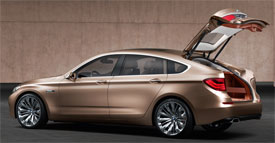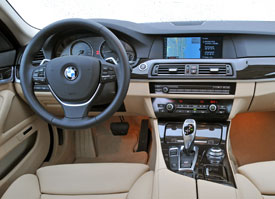2011 BMW 5-Series
With sporty moves and room for a family, BMW’s midsize 5-Series sports sedan has long been a segment benchmark and a MotorWeek favorite. But the all-new 2011 5-Series is something of a renaissance. While still packing a technology and powertrain wallop, it appears less aggressive and more executive. So let’s see if this really is progress.
Right off the mark, our visual take on the 6th generation 2011 BMW 5-Series is that it reminds us a lot more of the current flagship 7-Series than its direct predecessor. Yes, the twin kidney grille is naturally still there, but the previous 5’s Bangle-ized eyebrows are gone.
On the profile, the look is smoother but the character lines are more defined, all stretched over a 2-inch longer body, with a more telling, 3.2 inch longer wheelbase. The L-shaped LED taillights mimic the 7, while the rest of the toned down rear also looks more business than pleasure.
Top and bottom power are familiar. The 528i dons a three-liter straight six, rated at 240 horsepower, a bump up of 10. The 550i borrows the 7’s 4.4-liter twin-turbo 400 horsepower V8. Our 535i has the new powertrain, BMW’s latest 3-liter that trades two turbos for one twin-scroll unit. Output is unchanged, however, at 300 horsepower and 300 lb-ft of torque.
 A proper 6-speed manual is still standard on the six-cylinders, while optional with a six and standard on the V8 is BMW’s new gas saving eight-speed automatic.
A proper 6-speed manual is still standard on the six-cylinders, while optional with a six and standard on the V8 is BMW’s new gas saving eight-speed automatic.
Indeed, lots of Efficient Dynamics technologies have found their way into the 2011 5-Series, including regenerative brakes, electric power steering, and engine accessories that only produce engine drag when in use. Later in the year, x-Drive all-wheel drive will become available across the 5-Series lineup.
It didn’t take more than a few minutes at the track, however, to reassure ourselves that this more sedate looking 5 hasn’t dialed back performance one bit. Quick shifting our 535i’s manual delivers 0 to 60 in an impressive, and quite quiet, six seconds flat. The quarter mile mark came up in 14.5 seconds at 98 miles per hour. Both numbers getting close to the 5-Series GT V8 we tested last spring.
Just as laudable was our average 60 to 0 stopping distance of a very short 116 feet. The pedal wasn’t the firmest, but feedback was good, and fade nonexistent, from the all-wheel vented disc brakes.
Still, our handling test would be the big hurdle, an area where the previous 5-Series was a champion. Turn-ins are still quick, even if the electric power steering is a little numb. More curb weight means slightly more body roll, even in stiffer sport mode, but there’ s still little lack of poise, thanks to a new multi-link front suspension. So, when all was said and done, we were very happy.
I didn’t want to like the new 2011 BMW 5-Series. It got bigger, more luxurious, and less like the cars that I’ve always loved. Or so I thought. Sitting behind the wheel, it does feel like a 7-Series, and out on the highway it’s so smooth and quiet. But on back roads when you turn that wheel, well, everything I’ve always loved about a BMW sports sedan is front and center. My conclusion the new 5-Series is a great car.
 Inside, the new 5’s interior also takes on the 7’s more luxurious appeal. Our 535i came dressed to really impress with optional wood trim. BMW’s sensible, classy, horizontal architecture now has well-integrated 21st-century touches like adaptive cruise control and a lane departure warning system.
Inside, the new 5’s interior also takes on the 7’s more luxurious appeal. Our 535i came dressed to really impress with optional wood trim. BMW’s sensible, classy, horizontal architecture now has well-integrated 21st-century touches like adaptive cruise control and a lane departure warning system.
The fourth generation of iDrive appears either on a seven-inch screen recessed atop the now canted center stack, or with optional navigation on a larger 10.2-inch screen.
Rear seat knee room improves very slightly, while comfort is still above par for second-row passengers. 40/60 split-fold functionality is optional, as is a center pass-through.
In Government Fuel Economy Ratings, our manual 535i is rated at a decently frugal 19 miles per gallon city/28 highway. We managed an average of 22.3 miles per gallon on premium gas. On sale now, the 528i starts at $45,425. Our 535i begins at $50,475, and the 550i has a base sticker of $60,575.
With equal parts thrill and finesse, BMW has clearly taken the right path with this thoroughly modern car. Moreover, the 2011 BMW 5-Series remains one slick-shifting, fine-driving, midsize German sports sedan icon.
Specifications
- Engine: 3-Liter Turbo
- Horsepower: 300
- Torque: 300 Lb Feet
- 0-60 MPH: 6.0 Seconds
- 1/4 Mile: 14.5 Seconds @ 98 MPH
- 60-0 MPH: 116 Feet
- EPA: 19 MPG City/ 28 MPG Highway
- Mixed Loop: 22.3 MPG
2024 Toyota Land Cruiser
Toyota’s Go Anywhere Globetrotter Returns To U.S.
Every once in a while, we all need a reset. A time to get back to basics and prioritize the things that really matter. Well, for the Toyota Land Cruiser that time is now. So, let’s find out if that means bigger and better things for Toyota’s iconic off-roader.
The Toyota Land Cruiser’s status among the global off-road community is legendary, and it’s hard to imagine there’s any corner of the earth where a Land Cruiser hasn’t kicked up a little dust or mud. Well, 2024 sees the return of the Land Cruiser to the U.S. market after a 3-year hiatus, getting a major reset for the journey.
The reset comes mostly by no longer being based on the large three-row “300-series” chassis, but a new version of the smaller “200-series,” now known as the J250. As with the latest Tacoma, it uses the Tundra pickup’s full-size steel frame.
While the main Land Cruiser model, which goes by simply Land Cruiser, is packed full of luxury and convenience features, there is also a stripped-down model known as the 1958, honoring the first year the Land Cruiser made landfall here in North America. And it is that 1958 we have here, and we were glad to see it, as it also celebrates the original’s back-to-basics approach as a blank canvas for you to personalize as you tackle more and more adventures.
Not that it’s fully stripped down, as 8-inch touchscreen infotainment, a 7-inch full-color multi-information display, and automatic climate control are still standard. Plus, some seriously durable materials, and great heated cloth front seats that throw off some get serious 1990s Tacoma vibes.
But outside, there’s a definite lack of flashy trim and basic looking 18-inch wheels with Yokohama Geolander all-season tires; plus, big chunky bumpers and tilt-up back glass, which is a rarity that we appreciate. Though there is a little too much plastic in places that are sure to see some abuse if you do any significant off-roading.
It even feels a little rough around the edges, but for us it just adds to the rugged old-school utility vibe in a good way.
We did just that, both here in the Mid-Atlantic as well as in the California desert; and while there are some tech-forward driving aids, the actual hardware is in most cases plenty to get things done. That includes standard full-time dual-range four-wheel-drive, locking center and rear diffs, and 8.7-inches of ground clearance. A front stabilizer bar disconnect is also available to allow for increased articulation.
Who needs a V6 or even a V8 when you’ve got Toyota’s i-FORCE MAX setup at your disposal with 326 horsepower and 465 lb-ft of torque coming from a 2.4-liter turbo-four with an electric motor sandwiched between the engine and its eight-speed automatic transmission. Low speed torque delivery is impressive. It even feels a little rough around the edges, which may be a turn off to some, but for us it just adds to the rugged old-school utility vibe in a good way.
And it certainly feels quicker than an off roader needs to be, with an instant torque dump as soon as we eased on the throttle at our Mason Dixon test track; helping us get to 60 in 8.1 seconds and through the quarter-mile in 16.3 seconds at 86 mph. Considering the Land Cruiser’s terrain conquering mission, it behaved quite well in our handling course; it was plenty responsive to inputs, with less body roll than we expected and plenty of grip from the tires. The steering was light and quick but as expected didn’t provide much feel. Other than significant nosedive, braking performance was exceptional. Only 107-feet to panic stop us from 60 mph.
With the shift to the smaller size, there’s no more third row available, and cargo capacity now comes in at 46.2 cubic-feet with a max of a still healthy 82.1. Now, the best part of the Land Cruiser’s return is the entry price of $57,445. That’s about 30-grand less than what the last Land Cruiser went for back in 2021.
Whether it’s over the top fashion trends, mullets, or zombies; just when you think they’re dead, they come roaring back to life. Of course, we’re much happier to see the resurrection of this 2024 Toyota Land Cruiser than any of those things. Toyota is one brand that still recognizes the value of full-framed rugged rigs and has also acknowledged that sometimes less really is more. The Godfather of Toyota off-roading is back and better than ever.







